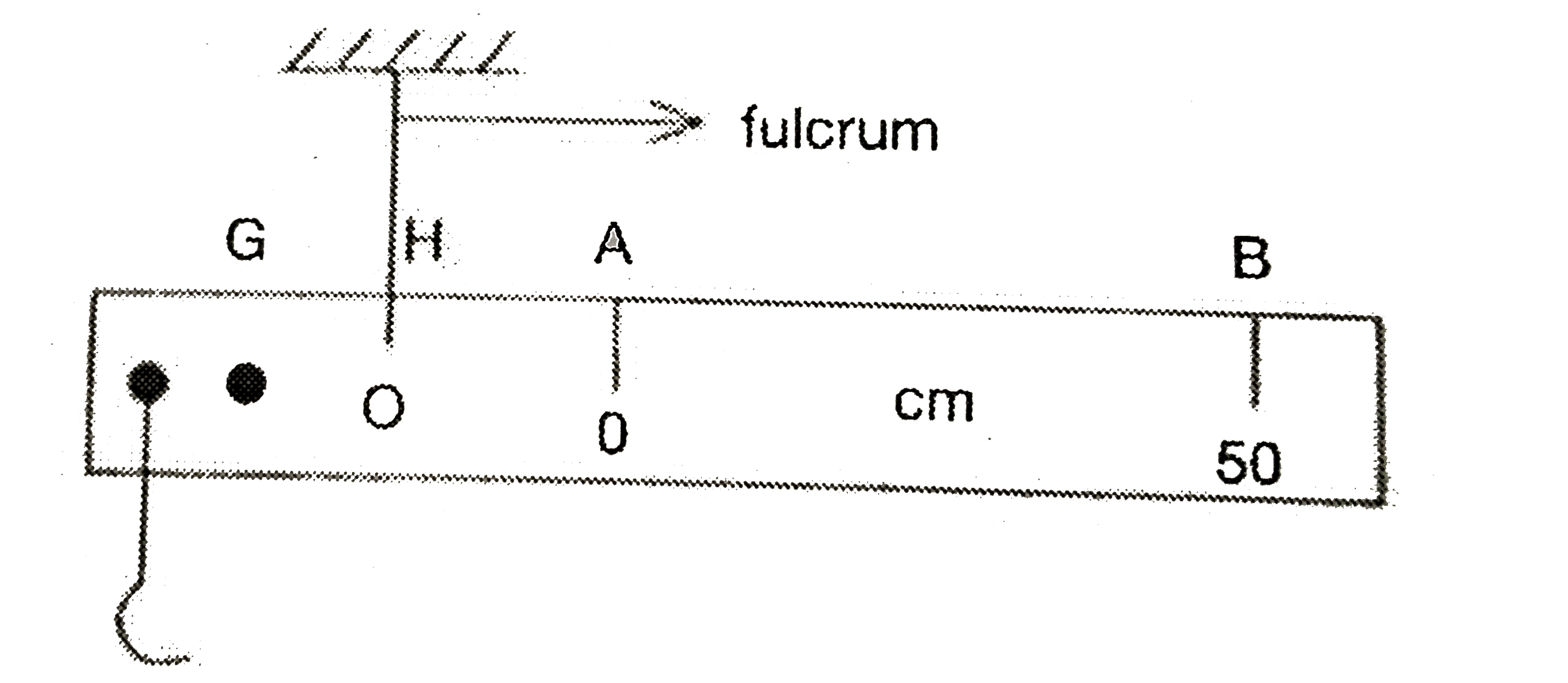A balance similar to a Roman steel yard is constructed such that the length of the scale on the beam of the balance is 50 cm and the least count on the scale is 1 mm. The zero mark of the scale is at a distance of 15 cm from the point of suspension of the balance. The hook that is used to attach the loads and the centre of gravity of the beam are at distance 8 cm and 5 cm, respectively, from its fulcrum. If the weight of the rider of the balance is 50 gf, find the weight of the beam, the maximum load that can be measured using the balance and its least count.
The information given in the question can be depicted as shown in the figure.

G is the position of centre of gravity. H is the position of the hook, O is the fulcrum, A and B are zero cm mark and 50 cm mark of the scale on the beam
Given OG=5 cm, OH = 8 cm and OA = 15 cm
Mass of the rider R = 50 gf.
Let x g be the mass of the beam
Then x (OG) = R(OA)
X=R(OA)OG=50×155=150g
Thus, the weight of the beam is 150 gf
Let L be the maximum load that is attached to the balance. Then
L(OH)+x(OG)=R(OB)
L=R(OB)−x(OG)OH=50(65)−150(5)8
=312.5g
The distance moved by the rider on the scale from its zero mark is directly proportional to the load attached.
Thus, 50 cm (=500 mm) corresponds to 312.5 g.
Thus, the least count of the balance = 0.625 g
Related Playlists
- BOOK - PEARSON IIT JEE FOUNDATIONCHAPTER - SIMPLE MACHINESEXERCISE - Level- 225videos
SIMPLE MACHINES
- BOOK - PEARSON IIT JEE FOUNDATIONCHAPTER - MODERN PHYSICSEXERCISE - Level 35videos
MODERN PHYSICS
- BOOK - PEARSON IIT JEE FOUNDATIONCHAPTER - WAVES MOTION AND SOUND EXERCISE - Level 310videos
WAVES MOTION AND SOUND
Similar Questions
A meter scale weighs 50 gms and carries 20 gm at one end , the scale balances when it is suspende at a distance x cm from other end . Then x I equal to
View SolutionIf the centre of gravity of a metre scale of mass 80g lies at the 45 cm mark, then which one of the following diagrams will show the balanced position of the scale.
View SolutionThe lengths of two rods measured by a meter scale are 50.0 cm and 10.0 cm, respectively. The least count of meter scale is 1 mm. Which measurement between two will be more correct?
View SolutionIn a Roman steel yard, the distance of the rider from its zero mark is proportional to the
View SolutionA metre scale is balanced on a knife edge at its centre. When a mass of 10 kg is kept at the 12 cm mark, the scale is balanced at 45 cm. What is the mass of the metre scale?
View SolutionA uniform metre scale 1 m long is suspended at 50 cm division. A known weight of 160 gwt is tied at 80 cm division and the scale is balanced by a weight of 240 gwt tied to the scale at a certain distance from the point of suspension on the opposite side. Calculate this distance.
View SolutionA spring balance has a scale that reads 0 to 20kg. The length of the scale is 10cm. A body suspended from this balance, when displaced and released, oscillates with period of π10s. The mass of the body is
View SolutionA metre scale is balanced on a knife edge at its centre. When a coin of mass 15 g is kept at the 12 cm mark, the scale is found to be balanced at 45 cm. What is the mass of the metre scale?
View SolutionA uniform meter scale balance s at the 40-cm mark when weihgt of 10g and 20g are suspended from the 10-cm and 20-cm marks respectively. The weight of the meter scale is
View SolutionA uniform metre scale can be balanced at the 70.0 cm mark when a mass of 0.05 kg is hung from the 94.0 cm mark.
Find the mass of the metre scale.View Solution

